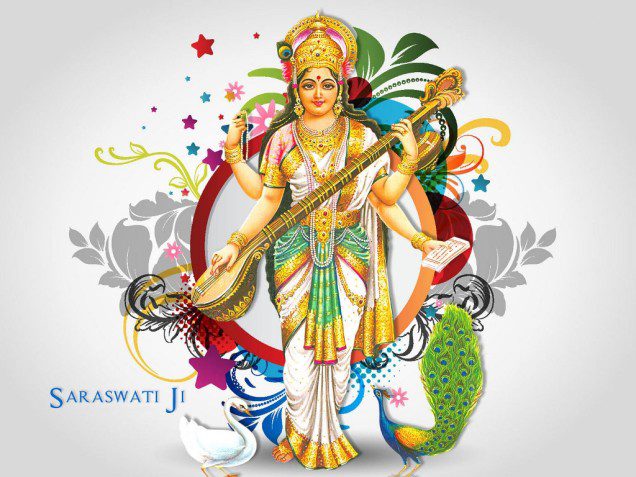Why we must honour Goddess Saraswati
The Veda Mata holds the pure white light of spiritual knowledge and all the rainbow colours of artistic expression.
The image of the feminine muse who inspires the poet with her beauty and her grace is a common theme in great poetry, from India and Persia to Greece and Rome, and modern Europe. Sometimes the muse is human but most often she is an artistic personification, extending to an angel or a goddess.
The idea of wisdom as a feminine principle is also common, whether as Sophia of the Christians, Prajna of the Buddhists, or Medha of the Hindus. Only where this feminine power of creativity and receptivity is honoured can either great art or profound mysticism flourish.
In India this cosmic feminine force has probably been granted her widest expression – in every aspect of the feminine human life from child and daughter, to wife, mother and grandmother, and throughout nature as the rivers, lakes, valleys, moon and flowers. She is called devi or the goddess and Hindu temples abound with her many forms and dances.
Saraswati from Vedic times
Saraswati represents vak or the divine word, but the same inspiration she reflects extends to all Hindu goddesses as arising from chit-shakti, the power of consciousness.
Saraswati is the most lauded goddess of the Vedas as Veda Mata, the mother of Vedic knowledge and all the Vedic deities. Saraswati was also the name of the vast river in northwest India on which the ancient Aryas cultivated the inner divine light through fire rituals and deep meditation.
Saraswati plays the veena, the symbol of divine music, holding the book of inner knowledge and the mala as the power of mantra. She has a charming human form, diversely portrayed in painting and sculpture throughout the centuries. She rides the swan of elegant movement, or the peacock that reveals an unbounded creativity arising from a unitary inner vision.
Saraswati means “she who abounds in wide currents and lakes”. She represents the lake of the still and peaceful mind, on which the lotuses of meditation open. Sarasvati is Rasavati or the one who holds the rasa, the inner essence of delight. She directs to look behind the outer forms of the world to the inner message of bliss or ananda.
In Hindu thought, the entire universe arises from, abides in and returns to ananda. The image of Saraswati reminds us that the pursuit of ananda is the highest form of culture and the real purpose of our embodied existence.
Saraswati Puja and Basant Panchami
Saraswati is honoured on the date of Basant Panchami, a celebration of the beauty of springtime. The fifth day of the waxing moon proclaims the growing light of life. Hers is a festival of learning, not as mere memorisation but as an irrepressible overflowing of the joy of awareness.
Worshiping Saraswati may be as simple as honouring one’s school books and educational tools, or children taking Saraswati dolls to school, such as occurs most often in the east of the country. These innocent forms of worship elevate the mind and heart, quite unlike the commercial toys of modern culture.
Sarasvati Puja includes formal rituals and temple worship on a larger scale as well. It is an honouring of inner calm and wisdom, encouraging us to be sensitive, compassionate and attuned to the whole of life.
In India, there has never been the sharp division of the sacred and the profane such as occurred in the West that has kept the spiritual and artistic realms apart.
Saraswati holds at once the pure white light of spiritual knowledge and all the rainbow colours of artistic expression. She represents the dance of nature as a spiritual effulgence. The inability to see the divine iconic light through an artistic image shows a limited perception. We should welcome and celebrate the full divine flow of grace!


No comments:
Post a Comment